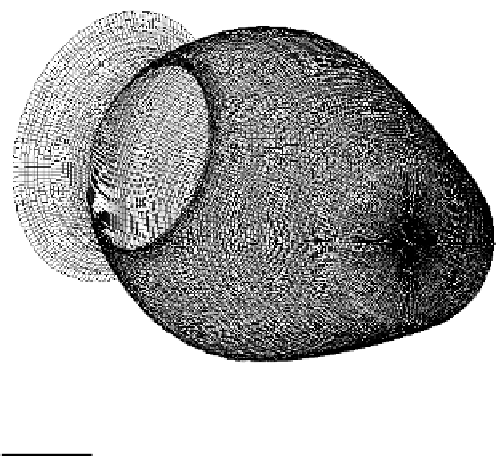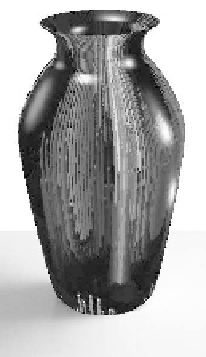Image Processing Reference
In-Depth Information
FIGURE 7.16: Quad decomposition of a wheel-thrown digital vase for tex-
turing. (See color insert.)
Reprinted from
International Journal of Arts and Technology
,
4
: 196-215, G. Kumar et al., Copyright 2011, with
permission from Inderscience Publishers.
tery. Fig. 7.16 demonstrates the quad decomposition of a wheel-thrown vase
and the resultant texture mapping.
To create realistic potteries (shown in Sec. 7.2.6) with thick walls, we need
to supply (connected and irreducible) digital generatrices having two parallel
segments—one for the outer wall and another for the inner wall including the
rim top. The procedure of generating digital surfaces of revolution is then the
same as that explained in Sec. 7.2.3. As the digital generatrix, in its entirety,
essentially consists of two parallel segments, which do not touch or intersect
themselves, we get a single irreducible digital curve segment. Such a gener-
atrix is an open digital curve segment (Chapter 4) with both its endpoints
lying on the axis of revolution, α, and having a “turn” corresponding to the
upper rim of the pottery to be generated. The inner segment defines the in-
ner digital surface (of revolution) and the outer, the outer surface. The inner
surface is mostly not visible. However, for further applications, the inner dig-
ital surface, which is an irreducible surface by definition (Sec. 7.2.2), may be
required. Since we have a double-sided (i.e., thick- and hollow-walled) digital
pottery, irreducible in nature, it becomes mathematically well-defined, and
hence would be compliant as an input to an algorithm in any relevant appli-
cation. An instance of a small yet representative thick-walled digital surface
of revolution, which is irreducible in nature, is shown in Fig. 7.15.








